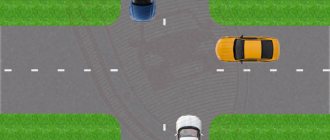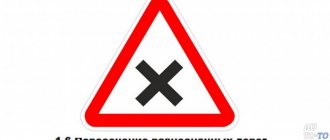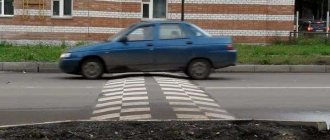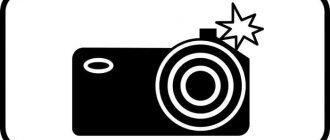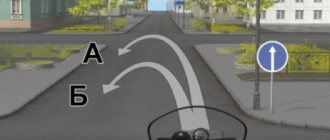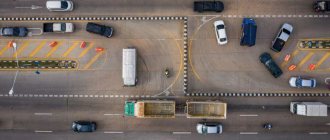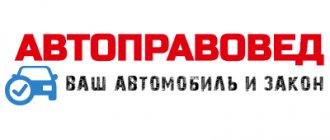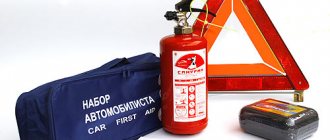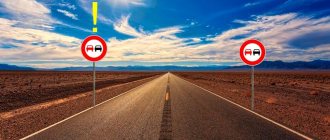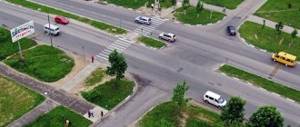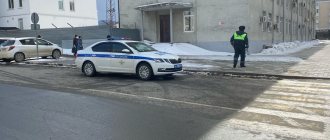Requirements of the sign Intersection of equivalent roads
According to traffic rules, an intersection is the intersection of carriageways of different roads at the same level.
It may be called:
- Adjustable. On it, the order of passage is determined by the light signals of the traffic light or the instructions of the traffic controller.
- Unregulated. You need to navigate by priority signs.
In turn, uncontrolled intersections are divided into equivalent and unequal. Each move has its own characteristics.
If a driver is driving on a road designated as the main road, then the installed sign at the intersection of equivalent roads (1.6) indicates that he does not have the right of way. In this case, the traffic rules regarding obstacles on the right come into effect - that is, you need to yield to those who are on the right hand of the driver. Those approaching from the left are not given priority.
A picture with a detailed description and explanation can be viewed on Internet resources dedicated to traffic rules and preparation for the theoretical part of the exam.
His requirements:
- reduce speed;
- cross the road only by giving way to vehicles approaching from the right (clause 13.11);
- give way to rail vehicles regardless of which direction they are moving from.
If each driver has an obstacle on the right, then the drivers must resolve the situation with the order of passage on their own. To give way in this case, a short switching of the headlights from high to low is sufficient.
In addition, traffic rules regarding the rules for turning, turning and crossing the roadway continue to apply at the intersection.
Signs denoting an equivalent intersection look like a black cross indicating the intersection of roads, enclosed in a triangle with a red border. According to the rules, they are installed within sight of the fork. The distance is 50-100 m in a populated area or 150-300 m on the highway. If sign 1.6 is duplicated by sign 8.1.1, indicating a specific distance in meters, then the distance can be changed upward.
Travel rules
There are certain rules of passage when driving at the intersection of equivalent roads.
U-turn
According to clause 13.11 of the traffic rules, the driver must allow a vehicle driving on the right to pass. Moreover, it does not matter which side it was on when entering the intersection. If during the turn it turns out to be on the right, then the driver must let it pass. If there is no traffic on the right side, you can pass. Important! When there is a traffic police representative at an intersection regulating vehicle traffic, or a traffic light, their instructions are more important than road signs.
It is worth remembering that the driver should not interfere with the movement of other vehicles when driving and turning around, so you should not:
- suddenly change driving direction;
- sharply reduce or increase the speed of movement.
Before turning, you must take the far left lane and avoid entering the oncoming lane, choosing the farthest turning trajectory. If there are prohibiting signs, then you should look for another place to turn around. Vehicles without the right of way are not allowed to enter the intersection if there is a traffic jam and they interfere with the free movement of other vehicles. Starting from 2021, the section of the intersection that the driver is not allowed to enter is marked yellow.
Did you know? At the beginning of 2021, the traffic police approved the proposal of the Moscow authorities to reduce the current standard of road signs from sizes 60x60 cm to 40x40 cm and 35x35 cm.
Overtaking
At the intersection of equivalent roads, overtaking other vehicles is prohibited. This is a strict rule that applies to non-main roads, and at the intersection of equivalent roads there is no main road. This maneuver will be accompanied by driving into the oncoming lane, which in such a tense and dangerous area as an intersection can lead to an accident, so overtaking at such an intersection will result in a considerable fine and temporary deprivation of driving privileges.
Who gives in
The basic principle of traffic rules (clause 13.11) is to give way to the one on the right. If at the intersection of road routes a situation occurs when each of the drivers experiences “interference on the right,” then they must independently decide the order of passage by quickly switching the low and high beam headlights. Important! At intersections, the tram has priority over other vehicles moving.
Such blinking will say “I’m the last one going,” that is, the driver giving such a signal allows other cars to pass. In the event that the driver with priority must make a U-turn or turn the car to the left, he is obliged to let other traffic moving towards him pass.
Liability for violation of sign 1.6
Sign 1.6 refers to warning types of signs. Responsibility for failure to comply with the restrictions that it establishes will arise in accordance with Article 12.13 of the Code of Administrative Offenses of the Russian Federation.
Sanctions will be applied for:
- Failure to provide the right of way.
- Creating obstacles to traffic (driving onto a roadway filled with parked cars).
If photo and video recording is carried out at an intersection, the driver will be issued an administrative violation report and a fine equal to 1,000 RUB.
In addition, liability may arise under other articles of the Code of Administrative Offenses if the driver:
- will overtake another car at an intersection. For such an offense, financial sanctions are provided (fine 5,000 RUB). Or the use of restrictive measures - the driver’s license will be temporarily suspended. The deprivation will last from 4 to 6 months (part 4 of article 12.15);
- will not turn on the turn signal before performing a maneuver (right or left turn, U-turn, stop). Threatens with a verbal warning or a monetary penalty of 500 RUB (Part 1 of Article 12.14).
All these errors appear due to insufficient theoretical knowledge. And they are not considered a basis for releasing the driver from liability.
General rules at equivalent intersections
There are other general rules for driving at equivalent intersections of roads, which any person driving a vehicle must adhere to:
- Before turning or turning, the driver must move the car in advance to a convenient edge on the road for movement.
- Reversing is not allowed at intersections and in places where you cannot turn around.
- On two-way highways that have 4 or more lanes, you must not enter the oncoming lane when trying to overtake a vehicle or go around an obstacle.
- There is a ban on stopping at the intersection and up to 5 m from the edge of the intersection of the road section. The exception is the side opposite the side passage of 3-way intersections, which is marked with a solid line or stripe.
- When turning, the driver must allow pedestrians and cyclists moving along the roadway onto which the car plans to turn to pass.
- It is strictly prohibited to enter an intersection with markings if there is a traffic jam ahead along the vehicle’s trajectory that will cause a forced stop. The exception is turning right/left.
Video: General rules at equivalent intersections
When crossing uncontrolled intersections, you must adhere to the following rules:
- At the intersection of equivalent roads, the driver must give the right of way to vehicles driving on the right.
- When turning to the left and making a U-turn, the driver gives way to vehicles that are moving on an equivalent route in a straight line or want to turn to the right.
Recommended reading:
- Traffic rules and signs when turning right
- Traffic rules about winter tires
- Traffic rules: sign “Driving in lanes at the intersection”
- Traffic violations recorded by camera
Visual acquaintance
For ease of perception, the signs from the priority group are triangular in shape. What does a Give Way sign look like? It is framed along the inner perimeter with a red border. Thanks to such visualization, it is possible to concentrate on information content. The purpose of the triangular sign is to warn motorists driving along a secondary road that a junction or intersection with the main road is expected nearby.
Due to one of the corners being turned down, the pointer, unlike its analogues, is easily and quickly read at almost any distance, and is also perceived even in conditions of bad weather and insufficient visibility. This practice can only be compared with the use of the “STOP” sign, which resembles a unique octagon. Features are used for quick identification.
It is important to know that the exterior of the “Give Way” triangle has not changed practically since its adoption more than a hundred years ago.
The informant has been used on public roads since the beginning of the last century. However, in the past it had a different purpose, as it urged novice motorists not to “disturb” other road users.
In reality, the surface of the triangle can be hidden due to external negative factors:
- snow deposits;
- dirt;
- sketched by vandals, etc.
This leaves a unique shape and layout that alerts the driver to an event along the way. If the sign had a classic shape with an upward angle, then with such concealments its meaning would not be readable. Foreign road services, in particular European ones, add the phrase “give way” in English inside.
Zone and duration of the “No Stopping” sign
The location where the sign is installed is the beginning of the section where there is a prohibition on stopping. The duration of its action is determined by additional signs installed, as well as by the second sign, which terminates the effect of the first. If there are none, the ban ends at the first intersection.
Signs can indicate the beginning of a particular settlement or its end. If there is a rectangular sign under the sign indicating the distance, the numbers on it indicate the length of the road where stopping is prohibited. Near the numbers there is an arrow indicating the direction of movement. The prohibition may be duplicated by road markings: a yellow stripe along the right side of the road. The end of the bar means that the ban ceases to apply.
To the sign with a sign with a down arrow
Since measuring the route while driving is quite difficult, it is possible to install two signs. The first is located at the beginning of the area where the ban is in effect, the second is at its end. If near the second sign there is also a rectangular sign with an arrow drawn downwards. She talks about the end of the ban.
To the end of the distance indicated on the sign
As already mentioned, sign 3.27, together with the indicated distance, indicates the duration of the zone where stopping is prohibited. Units of measurement are always marked next to the number. Most often these are meters, less often – kilometers. The beginning of the section will be where sign 3.27 is located. To make it easier to measure the distance, the sign can be supplemented with markings on the road.
If the prohibition zone, which is marked on the sign, is located further than the intersection, the command prescribed by the intersection will have priority. That is, the effect of the stop sign ends there.
With up and down arrows
If the site is long, several signs may be installed. In this case, another sign appears in the center of the zone, supplemented by signs pointing up and down. He says the restriction is still in effect. The first element is supplemented with a sign indicating the distance, and the last element with a sign with an arrow pointing down. Also in this case, instead of 3.27, the sign 3.31 can be set.
Until the sign of the end of the zone of all prohibitions
The meaning of sign 3.31 is the end of all restrictions. It can serve as a replacement for 3.27. This is relevant if there is more than one ban in force in a certain area. 3.31 is a white circle with a thin black stripe around its perimeter.
To the nearest intersection or populated area
There are situations when the second element indicating the end of the prohibited zone is missing. In this case, the ban on stopping the car will remain in effect until any element cancels it. This could be a crossroads or a sign indicating the end or beginning of a certain settlement.
The prohibition on stopping is relevant only for the direction of travel on which the sign is located.
Limiting the period of the ban by time
It happens that prohibition signs only work on specific days or hours. For example, a blue circle with a white Roman numeral 1 crossed out by a line indicates that parking is prohibited exclusively on odd numbers (3.29). If two sticks are crossed out on a blue background, on the contrary, you cannot stop on even days.
It is also possible to prohibit stopping during the day or at night. Usually the ban is valid during the day, but ceases to apply at night. This is indicated by the sign below the sign, which indicates the time interval during which the ban is in effect. For example, on the sign under the circle about. This means that you cannot stay here from 9 am to 9 pm.
How to determine the coverage area of a “No Parking” sign
Where the parking prohibited sign is located, the sign’s coverage area comes into force, and it ends after the first intersection that appears on the driver’s path.
However, here, as in any situation, there are certain nuances:
- if there is a bright yellow line marked as a marking at the edge of the roadway, then the effect of the road sign ends at the end of the marking;
- indicator 3.31 “End of zone of all restrictions” automatically ends the action of indicator 3.28;
- if a sign appears on the road more than once, then you should pay attention to the presence of an accompanying auxiliary sign under the sign - it may indicate the distance until the sign ends;
- the white letter “P” on a bright blue background allows parking and cancels the powers of the prohibition sign;
- if there are no intersections along the route, the sign will remain in effect until the end of the settlement;
- the operation of the road sign is not interrupted at exits from adjacent areas.
It is important to know what the “End of all restrictions zone” road sign looks like. This is a round road sign with a white background, crossed out by three oblique black lines.
